
 Data Structure
Data Structure Networking
Networking RDBMS
RDBMS Operating System
Operating System Java
Java MS Excel
MS Excel iOS
iOS HTML
HTML CSS
CSS Android
Android Python
Python C Programming
C Programming C++
C++ C#
C# MongoDB
MongoDB MySQL
MySQL Javascript
Javascript PHP
PHP
- Selected Reading
- UPSC IAS Exams Notes
- Developer's Best Practices
- Questions and Answers
- Effective Resume Writing
- HR Interview Questions
- Computer Glossary
- Who is Who
Addressing modes of 8085 in 8085 Microprocessor
Using mnemonics without any alteration in the content, data can be transferred in three different cases –
From one register to another register
From the memory to the register and
From the register to the memory
These can be guided by addressing modes. Addressing modes in 8085 can be classified into 5 groups −
Immediate addressing mode
Register addressing mode
Direct addressing mode
Indirect addressing mode
Implied addressing mode
Immediate addressing mode
In this mode, the 8/16-bit data is specified in the instruction itself as one of its operands. For example MVI E, ABH means ABH is copied into register A.
MVI E ABH
| Before |
After |
|
|---|---|---|
| (A) |
Any value |
ABH |
As an example, if we consider instruction MVI E, ABH then it means that ABH will be moved or copied to the register E.And, as a result, the previous value of E will get overwritten.
| Address |
Hex Codes |
Mnemonic |
Comment |
|---|---|---|---|
| 2000 |
1E |
MVI E, ABH |
E ← ABH |
| 2001 |
AB |
ABH as operand |
This instruction will have seven T-states as shown below.
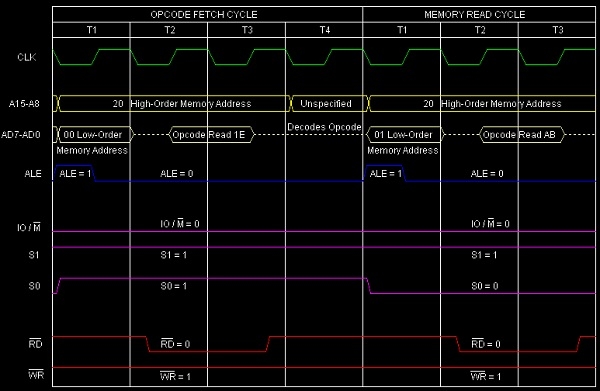
Summary - So this instruction MVI E, ABH requires 2-Bytes, 2-Machine Cycles (Opcode Fetch and Memory Read) and 7 T-States for execution as shown in the timing diagram.
Register addressing mode
In this mode, the data is copied from one register to another. For example, MOV A, B: means data in register B is copied to register A.
MOV E, H
It occupies only 1-Byte in memory. MOV E, H is an example instruction of this type. It is a 1-Byte instruction. Suppose E register content is AB H, and H register content is 9C H. When the 8085 executes this instruction, the contents of E register will change to 9C H.This is shown as follows.
| Before |
After |
|
|---|---|---|
| (E) |
ABH |
9CH |
| (H) |
9CH |
9CH |
| Address |
Hex Codes |
Mnemonic |
Comment |
|---|---|---|---|
| 2004 |
5C |
MOV E, H |
E ← H |
Note that H register’s content has not been changed at all. Although Intel has called it a “move” instruction, but actually, in reality, it seems to be a “copy” instruction.
The timing diagram of MOVE, H instruction is as follows -
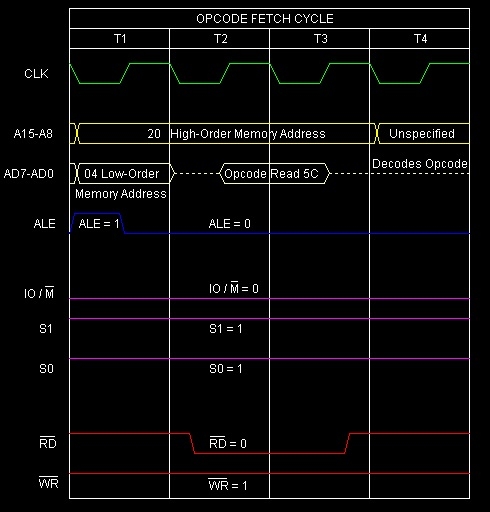
Summary - So this instruction MOV E, H requires1-Byte, 1-Machine Cycles (Opcode Fetch) and 4 T-States for execution as shown in the timing diagram.
Direct addressing mode
In this mode, the data is directly copied from the given address to the register. For example LDA 3000H: means the data at address 3000H is copied to register A.
LDA 4050H
Let us consider LDA 4050 Has an example instruction of this type. It is a 3-Byte instruction. The initial content of memory address 4050H is ABH. initial accumulator content is CDH. As after execution A will be initialized with value ABH. Memory location 4050H will still remain with the content ABH. The results of the execution of this instruction are as below –
| Before |
After |
|
|---|---|---|
| (4050) |
ABH |
ABH |
| A |
CDH |
ABH |
| Address |
Hex Codes |
Mnemonic |
Comment |
|---|---|---|---|
| 2008 |
3A |
LDA 4050H |
A ← Content of the memory location 4050H |
| 2009 |
50 |
|
Low order Byte of the address |
| 200A |
40 |
High order Byte of the address |
Here is the timing diagram of the instruction LDA 4050H –
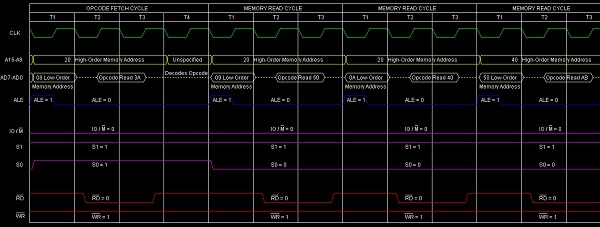
Summary - So this instruction LDA 4050H requires 3-Bytes, 4-Machine Cycles (Opcode Fetch, Memory Read, Memory Read, Memory Read) and 13 T-States for execution as shown in the timing diagram.
Indirect addressing mode
In this mode, the data is transferred from one register to another by using the address pointed by the register. For example, MOV A, M: means data is transferred from the memory address pointed by the register pair HL to the register A.
MOV E, M
It occupies only 1-Byte in memory. MOVE, M is an example instruction of this type. It is a 1-Byte instruction. Suppose E register content is DBH, H register content is 40H, and L register content is 50H. Letus say location 4050H has the data value AAH. When the 8085 executes this instruction, the contents of E register will change to AAH, as shown below –
| Before |
After |
|
|---|---|---|
| (E) |
DBH |
AAH |
| (HL) |
4050H |
4050H |
| (4050H) |
AAH |
AAH |
| Address |
Hex Codes |
Mnemonic |
Comment |
|---|---|---|---|
| 2008 |
2A |
MOV E, M |
E ← Content of the memory location pointed by HL register pair |
The timing diagram for this MOV E, M instruction is as follows –
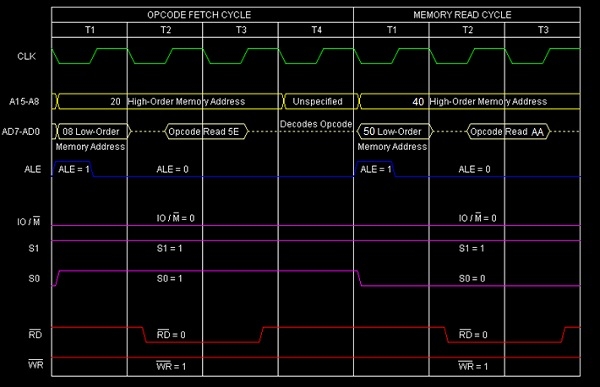
Summary - So this instruction MOV E, M requires 1-Byte, 2-Machine Cycles (Opcode Fetch, Memory Read) and 7 T-States for execution as shown in the timing diagram.
Implied addressing mode
This mode doesn’t require any operand; the data is specified by the opcode itself. For example: CMA, CMP.
CMP E
Let us consider one sample instruction CMPE falling in this category. It is a 1-Byte instruction so during execution of this instruction it will occupy only a single Byte in memory. The result of the execution of this instruction has been depicted with the following set of examples –
Example 1
| Before |
After |
|
|---|---|---|
| (A) |
50H |
50H |
| (E) |
70H |
70H |
| (Temp) |
Any value |
E0H |
| (F) |
Any values |
Cy=1,AC=0,S=1,P=0,Z=0 |
Example 2
| Before |
After |
|
|---|---|---|
| (A) |
70H |
70H |
| (E) |
50H |
50H |
| (Temp) |
Any value |
20H |
| (F) |
Any values |
Cy=0,AC=0,S=0,P=0,Z=0 |
Example 3
| Before |
After |
|
|---|---|---|
| (A) |
50H |
50H |
| (E) |
50H |
50H |
| (Temp) |
Any value |
00H |
| (F) |
Any values |
Cy=0,AC=0,S=0,P=1,Z=1 |
| Address |
Hex Codes |
Mnemonic |
Comment |
|---|---|---|---|
| 2004 |
BB |
CMP E |
Temp = Register A - Register E |
The timing diagram against this instruction CMP Execution is as follows –
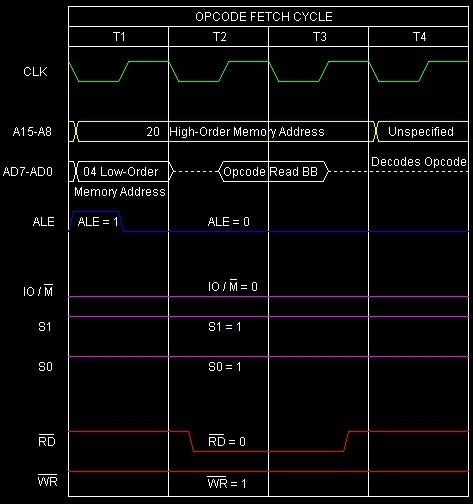
Summary - So this instruction CMP E requires 1-Byte, 1-Machine Cycle (Opcode Fetch) and 4 T-States for execution as shown in the timing diagram.

